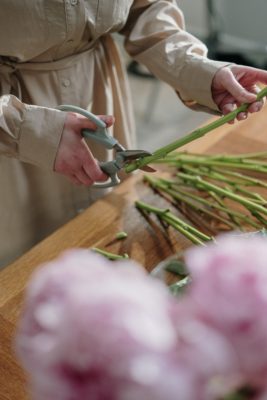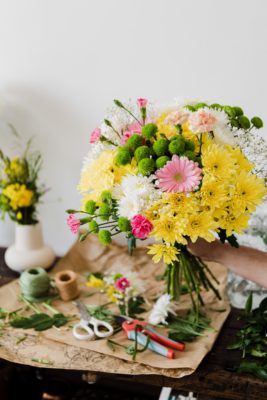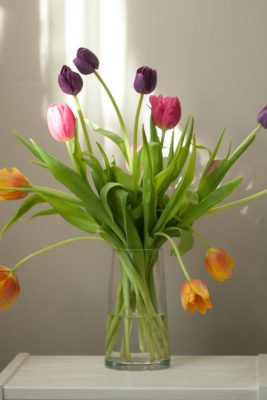Blog
How to Keep Your Flowers Fresher Longer
No matter the occasion, a well-appointed floral bouquet instantly brightens and enlivens a space. Unfortunately, these gorgeous tulips, roses, daisies, carnations, and all other types of blooms can fade far too quickly. Thankfully, over the years, florists have discovered a few flower care tips that can help you preserve that precious, fleeting beauty and help your bouquet last longer.
Tending to your flowers as soon as you get them home is vital to extending their life for as long as possible. Follow these proven flower guidelines carefully to ensure that your flowers are able to take in water properly and protect them from bacteria that form in the water. For optimal results, plan to incorporate daily maintenance as well.
Flower Care Tips
How to trim your stems
First, you’ll want to cut the stems by ½” to 1” from the bottom with a sharp knife or a pair of scissors. Avoid using a dull instrument that might crush or damage the flower’s ability to take up water. Cut the stems at an angle so that they don’t remain flat along the bottom of the vase so your flowers will have the best chance at survival. Ideally, this will not be a one-and-done deal. You should trim a bit more from the stems every few days.
Prune any leaves that will rest below the water line to avoid spreading bacteria. For example, Roses have guard petals that are the two or three outermost petals of the flower. They won’t open up fully until those petals are removed. Proper pruning will help your flowers look better and last longer. To maintain your bouquet for maximum health, check for dead or loose leaves each day to avoid bacterial rot.

Prep the water in the vase
The water in your flower vase serves two primary purposes: to nourish your flowers and prevent the spread of bacteria. There are several common ways to make this happen.

Other tips and Tricks
Here are some other simple ways that you can keep your flowers fresh and healthy:
Vodka: While adding a few drops of vodka to your vase may sound odd, the science behind it is sound. Alcohol helps to slow down the wilting process by inhibiting the production of ethylene. Ethylene is the gas that causes fruits, vegetables, and plants to ripen and mature. It makes sense, then, that keeping that at bay slows down the aging process for your flowers.
Soda: Carbohydrates, especially simple sugars, promote cell metabolism and feed your flowers. Adding ¼ cup of soda, like Sprite, can help your flowers stay perky and vibrant. Though adding darker beverages like Coke or Pepsi will also add sugar to the water, those aren’t recommended since they’ll color your water and turn it cloudy.
Aspirin: Dissolving a single crushed aspirin from your medicine cabinet in your vase water can do wonders for your flowers. Adding it to the water affects the acidity, lowering the pH, which facilitates water intake. Since water can travel through the stem faster, aspirin can help your flowers stay fresher, longer.
Pennies: Like adding crushed aspirin, adding coins, preferably pennies, to your water can affect the acidity of your water. Those acidic properties help to keep bacteria from growing in your water and will help your tulips flourish. Experts suggest adding one penny to the bottom of your vase in tandem with aspirin as described above for the optimal pH and maximum water intake.
ACV, Sugar, and Bleach: This is an alternative recipe for flower food that consists of 2 tablespoons of sugar, two tablespoons of apple cider vinegar, and ½ teaspoon of bleach added to 1 quart of water. Although this method isn’t as tried and tested as the sugar, bleach, and lemon or lime juice recipe, there are still plenty of people who would agree that it accomplishes the same things as flower food.
Bleach: Pouring just ¼ of a teaspoon into 1 quart of water in your vase will kill bacteria that may be found on your flower stems, your vase, or your water, helping to preserve them. Be careful, though. Too much bleach will harm your flowers and ultimately kill them. Using a small amount of bleach in conjunction with soda or vinegar will also increase water intake.
Refrigeration: Each night, remember to place your flowers in the refrigerator, just like florists do, to keep your flowers fresher for longer. If that’s not an option, try to keep your flowers away from drafts or extreme heat to allow them to thrive.
Flower Food
Flowers purchased from the grocery store or a florist usually come with a packet of flower food that should be dissolved into the water that you add to the vase. This optimal blend of ingredients will be the best way to protect flowers from bacteria and feed them to keep them vibrant and healthy.
Each packet generally contains a combination of these three ingredients: carbohydrates (in the form of sugars to promote growth), biocides (cleansing agents to ward off bacteria), and acidifiers (to adjust the pH and encourage water uptake). Follow the instructions on the label to properly dissolve and dilute the solution in the appropriate concentration. Ideally, you may want to grab a few extra packets when you can since you’ll need to replenish these ingredients whenever you change the water, which should be about once every two to three days, or when it becomes cloudy.
In a pinch, several everyday household items will serve as excellent substitutes for traditional flower food. Simply add one teaspoon of sugar, one teaspoon of bleach, and two teaspoons of lemon or lime juice to 1 quart of water. Replenish this mixture every time that you change the water.

Conclusion
These tips will help you to maximize your enjoyment of any floral bouquet. A little initial effort and routine follow-up care, even using just a few things that most people have lying around the house, will give you several extra days of blossoming beauty.


